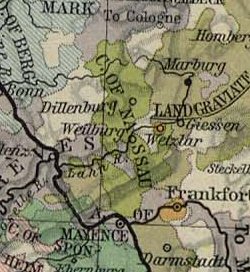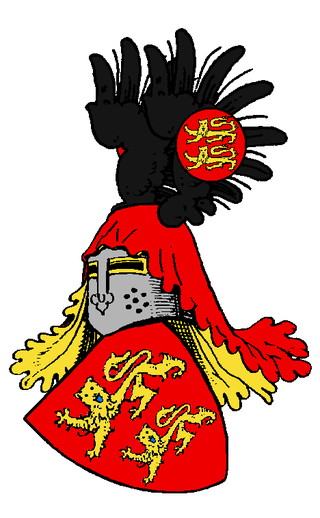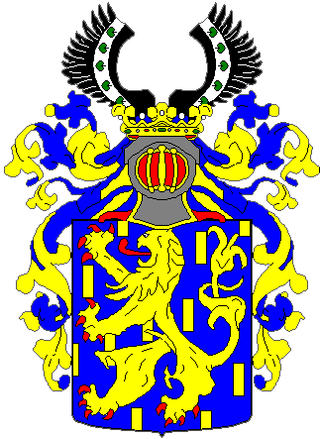Related Research Articles

The County of Nassau was a German state within the Holy Roman Empire and later part of the German Confederation. Its ruling dynasty, the male line of which is now extinct, was the House of Nassau.
Otto I of Nassau was Count of Nassau and is the ancestor of the Ottonian branch of the House of Nassau.

Countess Anne of Nassau-Siegen, German: Anne Gräfin von Nassau-Siegen, official titles: Gräfin zu Nassau, Vianden und Diez, Frau zu Breda, was a countess from the House of Nassau-Siegen, a cadet branch of the Ottonian Line of the House of Nassau, and through marriage successively Duchess of Brunswick-Lüneburg and Countess of Katzenelnbogen. She acted as regent of the Duchy of Brunswick-Lüneburg for her son in the period 1479–1486.
The Dernbach Feud was an over 100-year-long ongoing dispute in present-day Germany between the House of Nassau, several knightly families, and the Landgrave of Hesse. The conflict erupted mainly over property rights in Herborn and the surrounding area.
The Herborn Academy was a Calvinist institution of higher learning in Herborn from 1584 to 1817. The Academy was a centre of encyclopaedic Ramism and the birthplace of both covenant theology and pansophism. Its faculty of theology continues as the Theological Seminary of the Evangelical Church of Hesse and Nassau. The institution held the principle that every theory has to be functional in practical use, therefore it has to be didactic.

Ottilie of Katzenelnbogen, was by marriage Margravine of Baden-Baden.

Count John I of Nassau-Siegen, German: Johann I. Graf von Nassau-Siegen, was since 1362 Count of Nassau-Siegen. He descended from the Ottonian Line of the House of Nassau.

Count Otto II of Nassau-Siegen, German: Otto II. Graf von Nassau-Siegen, was since 1343 Count of Nassau-Siegen. He descended from the Ottonian Line of the House of Nassau.

Henry I of Nassau-Siegen was Count of Nassau-Siegen, a part of the County of Nassau, and ancestor of the House of Nassau-Siegen. He comes from the Ottonian branch of the House of Nassau.

Count Adolf I of Nassau-Siegen, German: Adolf I. Graf von Nassau-Siegen, was since 1384 Count of Diez, through his first marriage. With his brothers, he succeeded his father in 1416 as Count of Nassau-Siegen, and also inherited the County of Vianden in 1417. He descended from the Ottonian Line of the House of Nassau.

Count John II with the Helmet of Nassau-Siegen, German: Johann II. mit der Haube Graf von Nassau-Siegen, succeeded, with his brothers, his father in 1416 as Count of Nassau-Siegen. With his brothers, he inherited the County of Vianden in 1417, and also inherited half of the County of Diez in 1420. He descended from the Ottonian Line of the House of Nassau.
Emicho I, Count of Nassau-Hadamar, was the second son of Count Otto I of Nassau and his wife Agnes, the daughter of Count Emich IV of Leiningen-Landeck. Emicho was the founder of the elder line of Nassau-Hadamar. He was a cousin of King Adolf of Germany. He and his brother Henry fought on Adolf's side in the Battle of Göllheim on 2 July 1298.
Henry IV, Count of Waldeck was the ruling Count of Waldeck from 1305 to 1344. He was the second ruling count named "Henry", which is why some authors call him "Henry II". However, two earlier non-ruling members of the House of Waldeck are usually called Henry II and Henry III, and the subject of this article is commonly called Henry IV.
Rupert, Count of Nassau-Sonnenberg, nicknamed the Bellicose, was a son of Gerlach I, Count of Nassau and his second wife, Irmgard of Hohenlohe.

Count John III the Younger of Nassau-Siegen, German: Johann III. der Jüngere Graf von Nassau-Siegen, succeeded, with his brothers, his father in 1416 as Count of Nassau-Siegen. With his brothers, he inherited the County of Vianden in 1417, and also inherited half of the County of Diez in 1420. He descended from the Ottonian Line of the House of Nassau.

The County of Diez was a county of the Holy Roman Empire, centred around Grafenschloss in Diez, located in Lahngau. The county is first recorded in 1073, likely formed from the lands of the Conradine dynasty after their relocation to Swabia. The Counts of Diez gained prominence in the late twelfth century as strong supporters of the Hohenstaufen dynasty, earning it the nickname "Golden County."

Nassau-Hadamar is the name of two side lines of the Ottonian main line of the House of Nassau. The older line of the counts of Nassau-Hadamar existed from 1303 to 1394; the younger line existed from 1607 to 1711 and received the hereditary title of prince in 1652.
Agnes of Leiningen was a Countess of Nassau by marriage to Otto I, Count of Nassau. She was probably Regent of the County of Nassau for some time for her youngest son after the death of her spouse in 1289/1290.

Countess Ottilie of Nassau-Siegen, German: Ottilie Gräfin von Nassau-Siegen, official titles: Gräfin zu Nassau, Vianden und Diez, was a countess from the House of Nassau-Siegen, a cadet branch of the Ottonian Line of the House of Nassau, and through marriage respectively Countess of Katzenelnbogen and Countess of Tierstein.

Countess Adelaide of Vianden was a countess from the House of Vianden, the cadet branch of the House of Sponheim that ruled the County of Vianden, and through marriage Countess of Nassau-Siegen. She acted as regent of the County of Nassau-Siegen for her eldest son in the period 1351–1362.
References
- Karl Menzel (1884), "Matthias (Erzbischof von Mainz)", Allgemeine Deutsche Biographie (in German), vol. 20, Leipzig: Duncker & Humblot, pp. 657–663
- Johannes von Arnoldi, Geschichte der Oranien-Nassauischen Länder und ihrer Regenten, vol. 3, Neue Gelehrtenbuchhandlung, Hadamar, 1799, p. 85-91, Online
- P. Wagner: Die Erwerbung der Herborner Mark durch die Grafen von Nassau, in: Annalen des Vereins für Nassauische Altertumskunde und Geschichtsforschung, vol. 32, 1901, Rud. Bechtold & Co, Wiesbaden, 1902, p. 26-44), Online
- Jacob Wagner: Die Regentenfamilie von Nassau-Hadamar: Geschichte des Fürstenthums Hadamar, vol. 1, 2nd ed., Mechitharisten-Congregations-Buchhandlung, Vienna, 1863, Online